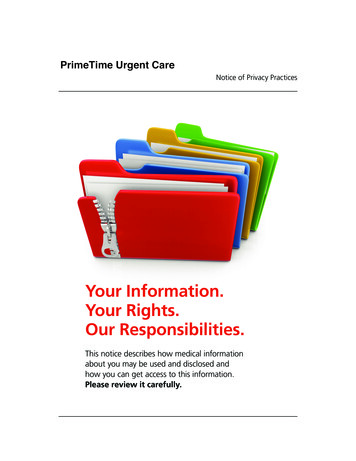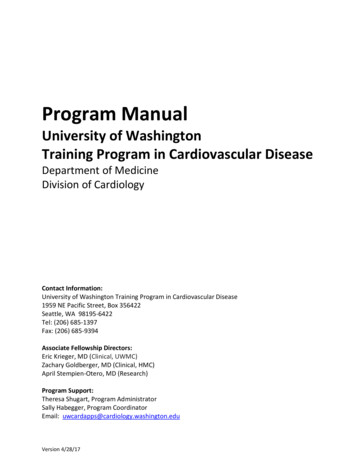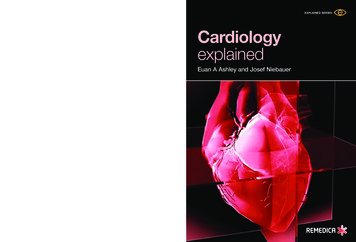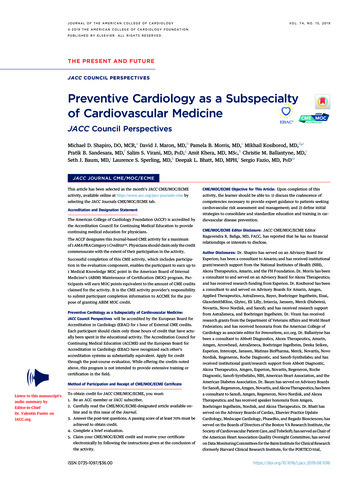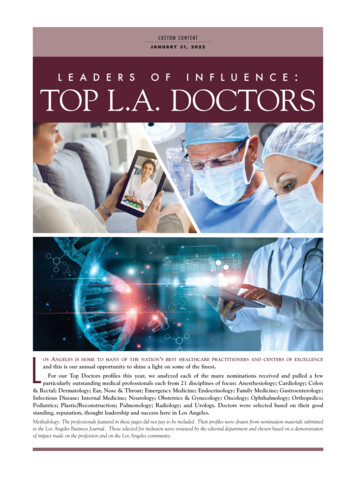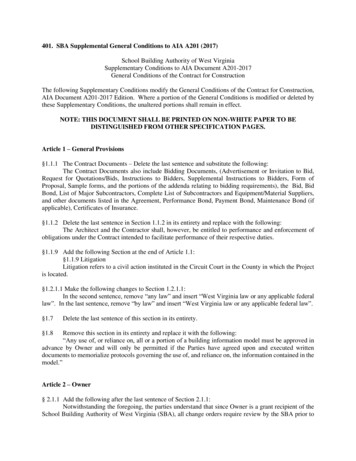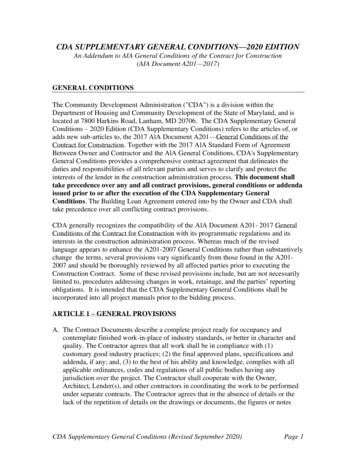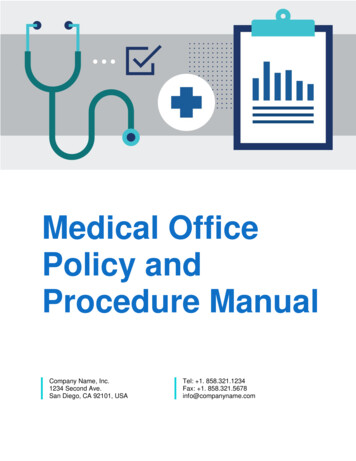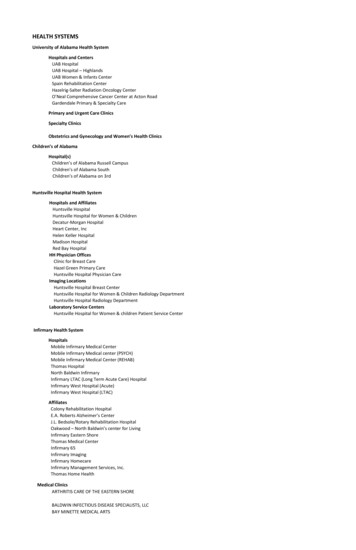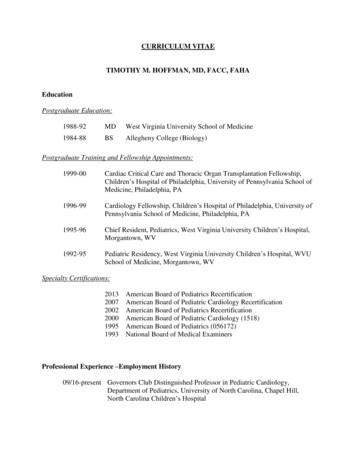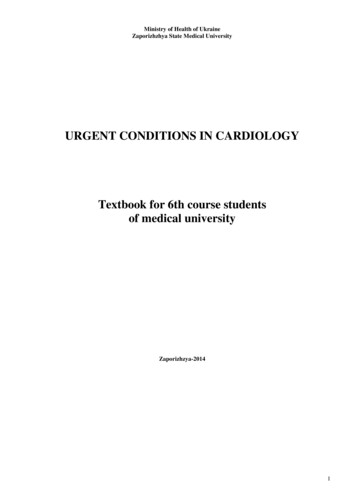
Transcription
Ministry of Health of UkraineZaporizhzhya State Medical UniversityURGENT CONDITIONS IN CARDIOLOGYTextbook for 6th course studentsof medical universityZaporizhzya-20141
УДК: 616.43-083.98(075.8) 20ББК 54.15я73Е 50Recommend by Central Methodical Council of Zaporizhzhya State Medical University as a studyguide for students and teachers of higher educational medical institutions (protocol 1 since25.09.2014.)Reviewers:S.Y. Docenko, MD, PhD, Head of Department of Internal Diseases-3 of Zaporizhzhya State MedicalUniversity.V.V. Syvolap, MD, PhD, Head of Department of Propedeutics of Internal Diseases with the Course ofPatients’ Care of Zaporizhzhya State Medical University.Authors: Head of Department of Internal Diseases-1, MD, PhD, Professor Syvolap V.D., docent,PhD Kalensky V.H., docent, PhD Lashkul D.A.This textbook content methods of educational process organization by Module 4 «Urgentconditions in clinic of internal medicine», content Module 1 „Urgent conditions in cardiology” inaccordance with the Program of Educational Discipline “Internal Medicine”, specialties: “Medicalbusiness” and “Pediatrics”.In textbook there are methodical guidelines for practical lessons and individual work for 6thcourse students; protocols of examination, diagnosis, treatment and prevention; clinical protocolsproviding medical care, tests for evaluation of students’ initial knowledge level and clinical tasks for selfstudy.2
ContentsМоdule 4 «Urgent conditions in clinic of internal medicine» Content Module 1. „Urgent conditions in cardiology” .Тopic 1: Management of patient with the complicated hypertensive crisis. Management of patient withcardiac asthma and pulmonary edema. . .Тopic 2: Management of patient with acute coronary syndrome .Тopic 3: Management of patient with acute myocardial infarction. Management of patient with cardiogenicshock. .Тopic 4: Management of patient with pulmonary embolism. Management of patient with sudden cardiacdeath. .Тopic 5. Management of patient with paroxysmal arrhythmias and conduction .Appendix 1. Protocol of patient management .3
Мodule 4«Urgent conditions in clinic of internal medicine»Final aims of ModuleStudents must be:Definite level of examination and treatment of inpatients with urgent conditions.Use in practice algorithms of examination and management in patients with urgent conditions.Perform in practice differentiate diagnosis of basic syndromes in clinic of urgent conditions.Master methods of treatment of urgent conditions in accordance with evidence medicine data.Use in practice standards of diagnostic and treatment of inpatients with urgent conditions.The organization of educational process should ensure participation of students in managementat least 2/3 of inpatients. If there isn’t possibility to gain access to patients of any category, students fillthe educational history with appropriate diagnoses. Need of writing of medical history is defined byassistant/docent (head of the chair curriculum department) in accordance with weekly data of presenceof appropriate patients in hospital departments.Course conducted in hospitals with emergency departments. Each student must work in ahospital weekly with 3 new/nondifferentiated patients. During course weekly students examined 6-10patients with dynamic observation and permanent patients. If for any reason a student inspects lessthan 2 patients per day, will studied treatment of patients who were hospitalized before. Quantity ofpatients for student curationn is defined by complexity of cases and possibility of students to workwith additional patients. Didactic classes conduct during the morning inspections, lections andpractical lessons. Assessment of administration of history case is conducted by teacher in time of workwith patient.Duties of the teacherThe teacher must constantly communicate with the student during the day. After examining thepatient he must hold a conversation with the student and state that:- Main complains were reviewed- Anamnesis collected carefully organized, logically, consistently, methodically correct- Physical examination completed methodically correct without violation of diagnostic procedures- Student demonstrates correct technic in definition of pathognomonic symptoms- He describes symptoms with usage of appropriate pathophysiologic terms- Student findings are correct- The student determined preliminary diagnosis correct and noted diseases for perform ofdifferentiate diagnosis- Student completed correct plan of examination and used the most informative diagnostic methods- He wrote correct administration list, noted doses of drugs, duration of treatment- He is able to ground reasonability of specified drugs- He is able to attach to patient for treatment, shows positive side of treatment and risk of absence oftreatment, demonstrates respect to patient and makes of patient active participant in treatmentprocess- He is able to report professionally about clinical condition of patient during 3-5 min- He make correctly short, professionally note in diary- He demonstrates responsibility in treatment of patients independently from age, sex, race, socialstatus, sexual orientation and financial resources- He may work in staff effectively- He demonstrates respective term to all members of medical staff (faultiness, responsibility andfairness- He accepts the terms that different minds and treatment features may be used.4
Content Module 1.Urgent conditions in cardiology(30 h/1.0 credit).Topic plan of practical classes ТopicHours12Management of patient with the complicated hypertensive crisisManagement of patient with paroxysmal arrhythmias and conduction523Management of patient with acute coronary syndrome74Management of patient with acute myocardial infarction. Management of patientwith cardiogenic shock. Tactic of treatment at sudden cardiac death.75Management of patient with pulmonary embolism.Final control.2225TotalConcrete aims:Students must:Definite level of examination and treatment of inpatients with urgent conditionsUse in practice algorithms of examination and management of inpatients with urgent conditionsPerform in practice differentiate diagnosis of basic syndromes in clinic of urgent conditionsMaster methods of treatment of urgent conditions in accordance with evidence medicine dataUse in practice standards of diagnostic and treatment of inpatients with urgent conditionsТopic 1. Management of patient with the complicated hypertensive crisis. Current standards ofdiagnostic and management of patients. Tactic of management of patients due to defeat of organstargets. Futher management of patients.Management of patient with cardiac asthma and pulmonary edema. Current standards ofdiagnostic and management of patients. Tactic of management of patients due to blood pressure level.Futher management of patients.Тopic 2. Management of patient with acute coronary syndrome. Current standards of diagnostic andmanagement of patients. Tactic of management of patients due to ST segment elevation. Futhermanagement of patients.Тopic 3. Management of patient with acute myocardial infarction. Current standards of diagnosticand management of patients. Tactic of management of patients due to ST segment elevation andpathological Q-wave. Futher management of patients.Management of patient with cardiogenic shock. Current standards of diagnostic and management ofpatients. Tactic of management of patients due to blood pressure level and stage of shock. Futhermanagement of patients.Тopic 4. Management of patient with pulmonary embolism. Current standards of diagnostic andmanagement of patients. Tactic of management of patients due to embolization level. Futhermanagement of patients.Management of patient with sudden cardiac death. Current standards of diagnostic and managementof patients. Technique of resuscitation. Defibrillation. Futher management of patients.Тopic 5. Management of patient with paroxysmal arrhythmias and conduction. Current standards ofdiagnostic and management of patients. Tactic of management of patients due to type of arrhythmia orblock. Electropulse treatment and electrostimulation. Futher management of patients.5
Тopic 1.Management of patient with the complicated hypertensive crisis. Curation of patient with cardiac asthma andpulmonary edema.Actuality. The issue of the day of modern cardiology are hypertensive crises (HC). A hypertension crisis is a acuteincrease of blood pressure (systolic and diastolic) higher individual norm, which, as a rule, is accompanied by appearanceor strengthening of disorders of function of organs-targets or vegetative nervous system. Hypertension crises are observedin 20-35% of patients with hypertensive disease, can arise up at all stages of it motion, and sometimes is it by an onlydisplay. For patients with hypertensive disease to the origin of hypertensive crisis all promote those factors which inordinary terms cause the increase of blood pressure and change reactivity of organism; the last is related to the type ofhigher nervous activity, state of pressing-depressing and humoral mechanisms. Pathogenesis of hypertensive crisis isdifficult and finally not studied, mechanism of their origin for patients with hypertensive disease and symptomatichypertensions are different. For patients with hypertensive disease of crises it is arisen up mostly on a background theprotracted overstrain of the central nervous system and hyperfunction of some systems of organism (simpatico-adrenal,renin-angiotensin-aldosteron and other) with violation of metabolism by exhaustion of compensatory possibilities. Ahypertension crisis is examined as a clinical syndrome which is characterized by the stormy, sudden intensifying ofhypertensive illness or symptomatic hypertension and shows up the sharp increase of blood pressure and row of general(excitation of the vegetative nervous system, hormonal and humoral violations) and regional symptoms with advantage ofcerebral and cardiovascular disorders. Without regard to that diagnostics of hypertension crisis is conducted easily and thisquestion the enormous amount of scientific-practical works is sanctified to, death rate at development of hypertension crisisfor patients with hypertensive illness very high. It is known that a death rate at hypertension crisis in Ukraine among theentire countries of Europe remains most high. Hypertensive crises are uncomplicated and complicated.Uncomplicated hypertension crisis is not accompanied by the defeat of organs of targets, it can be withoutsymptoms. The risk of heavy complications is small, that is why blood pressure can be reduced during a few hours anddays. Preparations mainly apply perorally, quite often such patients are treated by ambulatory.Complicated hypertension crisis accompanied by acute violation of functions vitally important organs as a resultof high blood pressure. It needs to be reduced immediately, preparations mainly enter parenterally, a patient is looked afterin the block of intensive therapy. Among complications of hypertension crisis sufficiently often there is left ventricularfailure (cardiac asthma and pulmonary edema).Aim of employment: to teach students to the modern tactic of conduct patients with the complicated hypertensivecrises, especially at development of acute left ventricular failure (cardiac asthma and pulmonary edema), diagnostics,differential diagnostics and prophylaxis at hypertension crisis, to determine the tactic of treatment at complicated bycardiac asthma and pulmonary edema hypertension crisis.A student must know:1. Determination of concept is a hypertensive crisis2. Classification of hypertensive crisis (uncomplicated, complicated)3. Concept of syndrome of left ventricular failure (cardiac asthma, pulmonary edema)4. Pathogenesis of left ventricular failure at hypertensive crisis5. Tactic of conduct (examination, treatment) of patients with hypertensive crises depending on complications6. Principles of medicinal treatment of patients are with a hypertension crisis, complicated by left ventricular failure7. Primary and secondary prophylaxis at arterial hypertensionA student must be able:1. To conduct physical examination of patient with hypertensive crisis2. To measure and interpret blood pressure3. To expose the different variants of complications of hypertensive crisis4. Fold the plan of inspection sick with hypertensive crisis, to ground application of basic invasion and non-invasivemethods of examination, to determine indication and contra-indication to it realization and possible complications5. On the basis of analysis of data of laboratory and instrumental inspection to conduct a differential diagnosis, groundand formulate a diagnosis6. To diagnose and give help at the complicated hypertensive crisis7. To demonstrate possessing moral-deontological principles of medical specialist and principles of professionaldeference to rank.A study is held as work of students in composition small brigades at a bed of patient with hypertensive crisis.During curation of patients a student uses corresponding Protocol and fills the cards of patients (see addition 1).Protocol of inspection, establishment of diagnosis, treatment and prophylaxis at arterial hypertension andcomplicated hypertensive crisis in accordance with the standards of evidential medicine on the basis ofrecommendations of European society of cardiologists/of European society of hypertension (2013), Ukrainianassociation of cardiologists (2011) and national Clinical protocols (2008)DIVISION OF ACTIVITYGreetingAcquaintanceComplaints of patient are inthe moment of inspectionGUIDANCE TO ACTIONSGreet and will appear to the patientCollect passport data of patient (name, surname, sex, age, residence, job and speciality)Define and go into detail the complaints of patient.At determination of complaints of patient pay attention to presence:6
Individual and domesticanamnesis, questioning byorgans and systemsMeasuring of blood pressure1) headache2) dizziness3) murmur in ears4) dyspnea5) coughDefine the presence of connection between complaints and level of blood pressureFind out the dynamics of disease, conduct questioning by organs and systemsAt questioning pay attention on a list relatively:1. duration and previous levels of increase of blood pressure.2. to the presence of symptoms which can testify to secondary character of arterialhypertension:- domestic anamnesis of kidneys disease;- illnesses of kidneys, infections of urinary ways, hematuria, abuse of analgeticfacilities;- to the reception of medicine (perorally contraceptives, drops against rhinitis,cocaine, amphetamines, steroids, unsteroidal anti-inflammatory preparations,erythropoietin’s, cyclosporine);- attacks of diaphoresis, headache, horror, palpitation (signs ofpheochromocytoma);- attacks of muscular weakness and tetania (signs of aldosteronism).3. To the presence of risk factors :- Arterial hypertension and cardiovascular diseases for family members;- dyslipidemias in domestic or individual anamnesis;- diabetes mellitus in domestic or individual anamnesis;- smoking;- obesity (will define food habits also);- level of the physical loading (amount of physical exercises, hours in twentyfour/hours week);- snoring, nightly apnoea.4. To the presence of symptoms of defeat of organs-targets:- brain and vision: headache, dizziness, loop of vision, transitory ischemicattacks, sensory or motor insufficiency;- hearts: palpitation, pain in a thorax, shortness of breath, edema of shins;- kidneys: thirst, polyuria, nycturia, hematuria;- peripheral artery: cold extremities, remittent lameness.5. Previous antihypertension treatment:- preparations;- efficiency of previous antihypertension treatment;- side effects at previous therapy.6. The presence of hypertensive crises (periodicity, level of increase of blood pressure,clinical displays)1. Before the beginning of measuring of blood pressure give to the patient to rest afew minutes2. Conduct measuring twice at intervals 1-2 min If there will be a wide differencebetween measuring - repeat measuring once again3. Use a standard cuff (12-13 sm of х a 35 sm ). For obese or thin patients it follows touse corresponding cuffs4. Set a cuff at the level of heart regardless of pose of patient5. Use I and V tones of Korotkov for authentication of systolic and diastolic bloodpressure6. Measure blood pressure on both hands (take into account higher indexes)7. Measure blood pressure on I and V min after passing of patient to vertical position(at a concomitant diabetes mellitus, for older persons and at suspicion in thepresence of postural hypotension)7
Physical examinationAt the inspection of patient estimate:1. State of patient2. Position at bedAt the inspection of patient pay attention to presence:Signs of defeat of organs-targets :- peripheral arteries (absence, decrease or asymmetry of pulse, cold extremities,ischemic defeats of skin);- hearts (localization and description of apex push, violation of cardiac rhythm,wheezes in lungs, peripheral edemata);- brain (noises are on the arteries of neck, motor and sensory violations);- retinas of eye (from data of fundoscopy, at possibility).Plan of examinationMade the plan of inspection sick taking into account the conservative, recommendedmethods, and also extended methods of examination, shown to the concrete patient (seefarther) Some inspections are conducted in parallel with a grant to the patient of the firstaid (ECG, X-ray of organs of thorax), other - after stabilizing of the patient state.1. Estimate levels:- glucose on an empty stomach;- general cholesterol, low density lipoproteins (LDLP), high density lipoproteins(HDLP) and triglycerides in the serum of blood;- to potassium in the serum of blood;- urinary acid and kreatinine in the serum of blood;- to haemoglobin and hematokrit.2. Analyse an urine.3. Analyse an electrocardiogram, expect the criteria of hypertrophy of the leftventricle (LV) of heart of Sokolov-Layone (SV1(2) RV5(6))4. Analyse X-ray of organs of thoraxConduct the analysis of recommended at the inspection of patient with hypertensivecrisis of methods of laboratory and instrumental inspection (at presence of data in ahospital chart):1. ECHO-cardiography - estimate the presence of signs of hypertrophy of LV of heart,as its remodelling, presence of systolic and/or diastolic dysfunctions of LV of heart2. Ultrasonic research of carotids - estimate the presence of atherosclerotic plaque andhypertrophy of wall (thickness of complex "intima-media")3. Quantitative determination of proteinuria - at microalbuminuria (30-300 mg/24hours), expect the size of correlation "albumen/kreatinine"4. To monitoring of domestic and ambulatory (24-hours) blood pressure - educe day'stype of increase of propulsion MODULEEstimate expediency of application for the concrete patient of the extended methods ofdiagnostics :1) defeat of heart, vessels, cerebrum (at complicated arterial hypertension);2) researches for clarification of secondary arterial hypertension (determination oflevels of renin, aldosteron, corticosteroids, catecholamins in plasma and/or urine,arteriography, ultrasonic research of kidneys and suprarenal glands, computertomography, magnetic resonance therapy of organs of abdominal region and other)To define prognosis of patient with arterial hypertension on the basis of stratification ofrisk by SCORE scale:- the sick groups of subzero risk have authenticity of fatal cardiovascular eventduring 10 years of 4%;- the sick groups of moderate risk have authenticity of fatal cardiovascular eventduring 10 years of 4-5%;- the sick groups of high risk have authenticity of fatal cardiovascular event during10 years of 5-8%;- patients with the complicated hypertensive crisis have very high authenticity offatal cardiovascular event.Estimate the capacity of patient, coming from recommendations of Clinical protocol ofconduct of patients with arterial hypertension:1. Patients with the complicated hypertensive crisis are temporally disabled. In future,after the leading out of sore from crisis subject of capacity decides depending on thestage of hypertensive disease and consequences of carried crisis.А. Patients with arterial hypertension of I and ІІ stages capable of working, subject tothe ambulatory inspection and treatment in policlinics domiciliary. In difficult caseshospitalizations are subject to the cardiologic, nephrological, endocrinology separationsof permanent establishments on the period of clarification f diagnosis and/or choice oftherapyLaboratory and instrumentalresearch(conservative methods)Laboratory and instrumentalresearch(recommended methods)Laboratory and instrumentalresearch(extended methods)Determination of prognosis ofpatientEstimation of capacity8
Formulation of diagnosisPlan of treatmentDiagnosticsoftypehypertensive crisisChoice of tactic of medicinaltherapyB. Patients with arterial hypertension of ІІІ stage must be directed on MSEC inconnection with the loss of capacity. Thus, the temporal loss of capacity for patients onarterial hypertension comes at hypertensive crisis, appearance of acute coronary failure,origin of attacks of cardiac asthma and pulmonary edema, sharp violations of cerebralcirculation of blood. In case of necessity of realization of MSEC at formulation ofclinic-expert diagnosis it follows to specify the stage of hypertensive disease, features offlow of illness, height and stability of blood pressure, character and frequency of crisis,presence of complications such as ischemic heart disease (IHD), heart failure (HF),chronic kidney failure, violation of cerebral circulation of blood. It is necessary to havethe detailed description of the state of eye ground /presence of haemorrhage, efficiencyof hypotension therapy, functional class of stabile angina pectoris of tension, presenceof concomitant diseases,. The defined value belongs to character of profession, terms oflabour. At presence of IHD it follows to consider heart trouble a basic disease. Withoutthe symptoms of heavy heart failure a capacity is determined by the state of cerebralcirculation of blood, in such cases a dominant role in examination belongs to theneurologist.Standards of diagnoses :- Hypertensive disease II stage, 2 degree. Hypertrophy of the left ventricle of heart.Hypertensive crisis, complicated by acute left ventricular failure (pulmonaryedema), HF ІІ-А, with preserved ejection fraction, ІІ FC (NYHA). Risk 4.- Hypertensive disease III stage, Cardiac complicated crisis (date), 3 degree, IHD.Diffuse cardiosclerosis. Paroxismal form of ventricular tachycardia (date).Medicinal cardioversion (date), HF ІІ-A, with preserved ejection fraction, ІІ FC(NYHA). Risk 4.- Hypertensive disease ІІІ stage. Cerebral complicated криз (date). Acutehypertension encephalopathy (date), HF ІІ-А, with preserved ejection fraction, ІІFC (NYHA). Risk 4.Conduct the plan of treatment, which must include nonpharmacological andpharmacologicaltherapyof A kind will define crisis:1. Criteria of crisis: outbreak, considerable increase of blood pressure, appearance orstrengthening of symptoms from the side of organs-targets2. Criteria of uncomplicated crisis: the acute making progress defeat of organs-targetsabsents, strengthening of symptoms takes place from the side of organs-targets(headache, pains in area of heart, extrasystoly) or from the side of the vegetativenervous system (vegetative violations, shaking, polakiuria)3. Criteria of complicated crisis: acute making progress the defeat of organs-targetswith development:- acute myocardial infarction- stroke- transitory ischemic attack- acute dissection aneurysm of aorta- acute left ventricular failure- unstable angina- eclampsias- acute hypertension encephalopathy- bleedingConduct of patients with complicated hypertensive crisisMedicinal therapyBy the mean of choice for purchased of heavy hypertensive crisis /GC of second type byN.А.Ratner/ Clophelinum continues to remain. At intravenous slow introduction 0,5-1мl of a 0,01 % solution of Clophelinum on 10-15 ml of isotonic solution of chloride ofsodium of BP goes down through 5-15 min. At the same time such rapid decline of BPdoes not worsen the state of cerebral and coronal circulation of blood. If to enterClophelinum in a muscle, then the decline of BP is marked on 30-60-th min. Forwarning of orthostatic collapse it is necessary to adhere to the bed mode during 2 hoursafter parenterally introduction of preparation.In stationary terms with cerebral symptoms at hypocinetic GC/of the second type/appoint a 0,25 % solution of droperidol a patient for 4-6 ml in a vein on 20 ml of a 0,9% soluble-sodium of chloride or 20 ml of a 5 % solution of glucose. At slowintroduction to the vein of droperidol already on 2-5-th min gets better feel sick and BPgoes down. However hypotension effect of short duration, somewhere near one hour.That is why it is expedient to combine droperidol with Lasix for 2-4 ml. At theexpressed psycho motor excitation and appearance of cramps droperidol combine with9
seduxen or elenium. For older patients with the expressed cerebral and coronalatherosclerosis, and also an III stage of hypertensive disease BP it is expedient to reduceslowly, during 20-40 min, to warn sharp violations of cerebral and coronal circulation ofblood.If GC flows with the minimum symptoms of sharp violation of cerebral circulation ofblood, defeat of eyes and hypertensive encephalopathy, then Clophelinum or droperidol/better droperidol/ combine with euphylin. 10-15 ml of a 2,4 % solution of euphylinenter in a vein on 10 ml of a 0,9 % solution of chloride of sodium. In the complement ofthe combined therapy it costs to plug 2-4 ml of Lasix in a vein.For patients with sympathoadrenal GC marked sine tachycardia, extrasystoly, highsystolic and pulse pressure, excitation, fear. In such cases appoint in a vein 3-5 ml of a0,1 % solution of obzidan /anaprilin/ on 10-15 ml of a 0,9 % solution of chloride ofsodium. The decline of BP and deceleration of heart rate comes through 5-10 min. Thehypotension action of medicine proceeds a few hours. For warning of relapse GCappoint anaprilin for 80-120 mg/twenty-four hours.If acute left ventricular failure is diagnosed on a background of GC, then preparations ofchoice – ganglion blockersof rapid action, intravenouse introduction of nitroglycerine.In muscles enter 0,5-1 ml of a 5 % solution of pentamin. BP goes down through 15-30min and remains mionectic during 3-4 hours For achievement of more rapid andexpressed hypotension effect combine 0,5-1-2 ml of a 5 % solution of pentamin with 2ml of a 0,25 % solution of droperidol on 100-150 ml of a 0,9 % solution of chloride ofsodium, medicine enter in a vein with speed 15-30 drops for a minute under control ofBP. In the first 10-20 min BP goes down on 25-30 % as compared to a weekend. At theclinical displays of cardiac asthma simultaneously appoint Lasix for 40-80 mg andinhalations of oxygen with foam extinguisher(ethyl spirit,). Instead of pentamin usearfonad or benzohexoniy. The rapid decline of BP, especially for older people, canresult in a collapse and violation of regional hemodynamics. With a prophylactic aim apatient must be abed 2-3 hours.At treatment GC take into account clinical symptoms and impression of internalss. Fortherapy of the urgent states, hypertensive encephalopathy, acute left ventricular andkidney insufficiency, dissection of aneurysm, eclampsia ideal hypotension drug isremained nitroprussid of sodium at 0,25-10 mcg/kg/min intravenously at drops withbeginning of action at once. Duration of introduction from a few hours to twenty-fourhours, but the maximal dose of drug is entered during 3-7 min Diazoxyd (hyperstat)enter stream intravenously 50-150 mg or for 15-30 mg/min, beginning of action through1-2 min, and a hypotension effect proceeds a few hours. Preparation is appointed athypocinetic GC, malignant arterial hypertension, hypertensive ancephalopathy, GC withsharp kidney insufficiency. GC at phochromocytoma take off by phentolaminum,tropafen or nitroprusside.From physical methods assign mustard plasters, hot baths of feet, cold for a head. Onoccasion for liquidation of the phenomena of cardiac asthma and pulmonary edema usebloodletting for 300-500 ml. Such treatment is shown to the patients of young andmiddle age. To the older persons with the expressed cerebral atherosclerosis assignmedical leech on processus mastoideus, for 2-4 leeches from every side.Reason of GC are psycho-emotional overstrains with blowing off adaptationmechanisms, meteorological factors, hormonal disorders. In declining and senile yearsthe sudden increase of BP can be provoked by a sharp cerebral ischemia as a result ofcerebral atherosclerosis, neck osteochondrosis or chronic circulator cerebralinsufficiency. Finely, GC can cause acute myocardial ischemia with reflex excitation ofCNS and sudden extrass of catecholamins in blood. Thus, during realization ofprophylactic measures it costs to take into account the mechanism of development ofGC, adjust the rhythm of life.Pyrroxan in a dose 0,045-0,06 g/24 hours is caused by a positive effect at thediencephalic crises of sympathoadrenal genesis from hyperadrenalinemia, reducesexcitability and paroxysmal activity of cortical and subcortical structures of brain. Inmenopause appoint a correcting hormonotherapy which quite often results indisappearance of GC. Women with progesteron insufficiency 6-8 days prior tomenstruation accept diuretics: triampur, hypothiasid.If appearance of GC is predefined by the sharp ischemi
This textbook content methods of educational process organization by Module 4 «Urgent conditions in clinic of internal medicine», content Module 1 „Urgent conditions in cardiology” in accordance with the Program of Educatio
